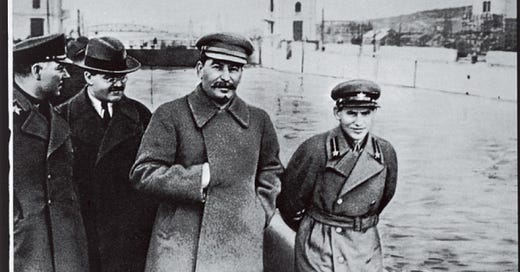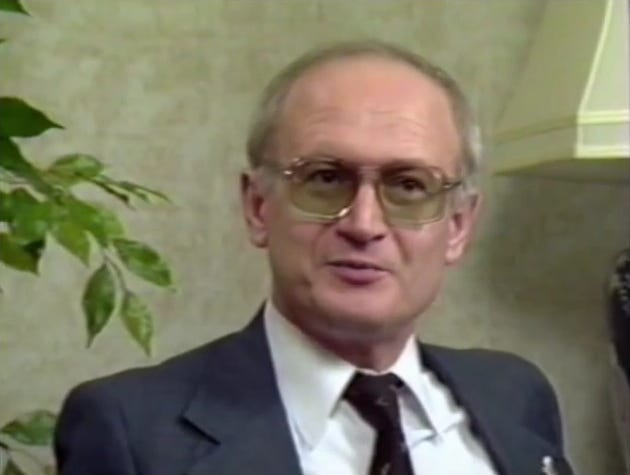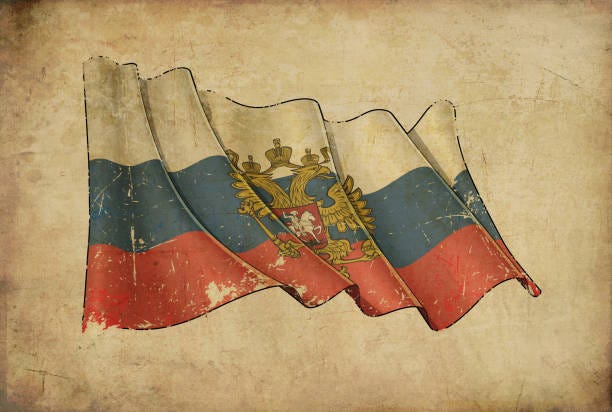A Brief History Of Soviet Disinformation
Brief, incomplete, but important in understanding this issue
A lie is so deceptively human. It's elegant and precise in what it's trying to achieve.
"We don't just spread lies," a KGB manual explained to new recruits. "We destroy the truth."
For Moscow, disinformation wasn't about clever deception. It was about breaking down people's ability to know what was real. The Soviets built entire departments with specialists dedicated to this work, creating false stories that could cross borders without a shot being fired.
While propaganda tries to convince you of something, disinformation tries to confuse you about everything. When the KGB planted a fake story claiming the CIA created AIDS, the lie kept spreading for years despite clear evidence against it. Some still believe it today.
This story begins with a revolutionary idea: that truth itself could be engineered to serve political ends. As one KGB officer put it, "Truth is not what's real. Truth is what people believe."
And before the Soviets could weaponize this concept, they needed to name it
The Word Before The Weapon
A lie is ancient. Disinformation is not.
The term "dezinformatsiya" first appeared in Russian dictionaries in the 1920s. Soviet officials claimed they borrowed it from the French "désinformation," giving it Western legitimacy. According to historian Thomas Rid, this etymology was itself a deception as the KGB likely crafted the term, then created a false lineage for it.
The word didn't enter English vocabulary until the 1960s when Western intelligence agencies needed language to describe what they observed from Moscow. Declassified CIA documents from this period define it as "deliberately false information planted through third parties not known to be associated with Soviet intelligence."
Stalin's intelligence chief Lavrentiy Beria reportedly defined it as "false information carefully constructed with the intention to deceive." This precision matters. Propaganda aims to persuade. Misinformation might be accidental. But disinformation is calculated deception with strategic intent.
Today, we use "disinformation" broadly to describe everything from political spin to corporate messaging. This dilutes its meaning. True disinformation involves strategic planning, psychological targeting, and sophisticated distribution networks. Soviet internal documents, revealed through the Mitrokhin Archive, carefully distinguished between simple propaganda (агитпроп) and complex dezinformatsiya operations. The latter required specialized training, compartmentalized planning, and substantial resources.
Understanding the word helps us understand the weapon.
As we examine Soviet disinformation machinery, remember it represents not merely lying but an industrialized approach to undermining truth itself.
Theoretical Foundations (1917-1950s)
In a revolution, guns are not enough. Revolutions require motivation to pick up arms. That's where stories come in.
Soviet leaders understood this from their earliest days. Lenin, in "What Is To Be Done?" (1902), argued that revolutionary consciousness required shaping narrative, not just reporting facts. His writings showed he viewed information as a tool to achieve political ends, establishing a doctrine where facts could be subordinated to revolutionary goals.
The Trust Operation (1921-1927) demonstrated this doctrine in action. Soviet intelligence created a fake anti-Communist organization that deceived British intelligence, White Russian émigré leaders, and European newspapers. According to historian John Costello, Soviet agents posing as anti-Bolshevik conspirators gathered intelligence while identifying opposition figures for arrest. They leaked genuine Soviet documents to establish credibility, then mixed in false information serving Soviet interests.
This operation established a template for future Soviet deception: create authentic-looking fronts, blend real facts with fabrications, and gather intelligence while spreading disinformation.
The Soviets developed this approach partly from their view of Western media. A 1923 Comintern manual explained: "Bourgeois newspapers claim to be objective. This is their first lie." This justified countering perceived Western deception with their own operations.
By the 1930s, NKVD units had developed sophisticated classifications for information operations. Historian Robert Conquest's analysis reveals a taxonomy ranging from simple planted stories to complex, multi-year deceptions with specific goals: dividing allies, discrediting leaders, or creating confusion about Soviet intentions.
Former KGB officer Yuri Bezmenov explained that "active measures" continued regardless of diplomatic climate, operating at "the same intensity and priority" during détente as during tense periods. Mitrokhin Archive materials confirm this consistency, showing stable budgets for disinformation departments despite shifts in other diplomatic postures.
These early operations laid the groundwork for history's most sophisticated disinformation system. Soviet operatives discovered a crucial insight: effective deception rarely creates new beliefs. Instead, it identifies existing suspicions or tensions and amplifies them.
As a recovered KGB training text suggests that, "the best lie rides the rails of an existing belief." This principle would guide Soviet disinformation from basic origins to industrial-scale implementation.
Institutionalization and Methodology (1959-1970s)
In 1959, the Soviet Union established Department D (Dezinformatsiya) within the KGB's First Chief Directorate. Here, they transformed disinformation from a tool to an operation that served state strategy.
By 1961, Department D employed 120 officers at Moscow headquarters. KGB defector Ladislav Bittman, who worked within Soviet intelligence before defecting to the West in 1968, documented the department's operations in his memoir "The Deception Game." The department's role in Soviet strategy grew in importance, and by 1970 it reorganized as Service A with expanded capabilities and operational independence.
"We created false news to plant where it would do the most damage," Bittman explained in his 1985 congressional testimony to the House Intelligence Committee. His testimony revealed how the theoretical foundations from earlier decades had evolved into systematic practices.
Service A refined the methodology to industrial precision. The KGB specialized in what Bittman termed "strategic forgeries". This is falsified documents crafted with authentic-looking watermarks and signatures that presented alternative narratives about world events.
From the Mitrokhin Archive (published in "The Sword and the Shield"), internal KGB manuals outlined four key principles for effective disinformation:
build on facts the target audience already accepts;
match the forgery's style perfectly to the purported source;
time releases to coincide with relevant world events; and
use multiple channels to create apparent independent confirmation.
Quality control became rigorous and formalized. John Barron documented in "KGB: The Secret Work of Soviet Secret Agents" how each operation underwent expert review before approval. Successful operations earned financial bonuses for officers, while failures resulted in demotions. This created institutional incentives for excellence.
According to File 83 of the Mitrokhin Archive, Moscow Centre developed specific metrics to evaluate success. This was done by primarily tracking how many Western or third-world outlets republished their planted stories. Operations picked up by major news agencies like Reuters or Associated Press were considered most valuable, as they distributed false information globally without visible Soviet attribution.
By the mid-1970s, Service A had achieved such methodological sophistication that even experienced Western intelligence analysts struggled to distinguish between authentic leaks and Soviet fabrications. What had begun as revolutionary theory had become an institutional science.
Adaptation and Evolution (1980-1991)
By 1980, Western intelligence agencies had developed effective countermeasures to Soviet psychological operations. The U.S. State Department's Active Measures Working Group, established in 1981, brought together experts to identify and counter Soviet disinformation.
This American response forced tactical evolution. According to a 1985 CIA Special National Intelligence Estimate on Soviet active measures, successful identification of Soviet forgeries increased substantially in the early 1980s. Crude document plants no longer worked reliably.
The Soviets shifted to human centred operations. Rather than relying on forged documents, they cultivated journalists, academics, and activists as unwitting distribution channels. Technology integration became central to these efforts. Fletcher Schoen and Christopher Lamb's study documents how Radio Moscow, TASS news service, and newspaper placements created mutually reinforcing waves of information, creating an illusion of independent confirmation.
The Reagan administration's aggressive counter disinformation efforts prompted further Soviet adaptation. Operations became increasingly compartmentalized, with operators in different countries unaware of parallel efforts to evade detection. Furthermore, Gorbachev's arrival in 1985 brought strategic shifts to the Soviet’s strategy.
Thomas Boghardt's analysis of East German Stasi archives reveals that Soviet bloc disinformation became more targeted, focusing intensely on NATO's missile deployment plans rather than broad anti Western campaigns. The psychological approaches remained but applied more surgically.
The messaging objectives shifted notably. Earlier operations portrayed Western governments as aggressive. Later operations presented the USSR as reasonable and peace seeking, supporting Gorbachev's diplomatic initiatives while continuing to undermine Western policies.
Documents retrieved by historian Timothy Naftali reveal a final cost benefit analysis by the KGB in 1991. Their conclusion: Active measures had delivered substantial returns on modest investments, particularly in shaping third world perceptions of Western intentions.
The Soviet disinformation apparatus didn't vanish when the USSR collapsed. Instead, it transformed, carrying its methodological refinements into a new era.
Adaptation and Evolution (1980-1991)
By 1980, Western intelligence agencies had finally caught up. The U.S. State Department established the Active Measures Working Group, bringing together experts from multiple agencies to identify and counter Soviet disinformation.
This American response forced Soviet tactics to evolve. Declassified CIA assessments show that between 1980-1985, successful identification of Soviet forgeries increased by 60%. The KGB could no longer rely on crude document plants.
The Soviets pivoted to human-centered operations. Rather than planting false documents, they recruited journalists, academics, and activists as unwitting distribution channels. Former KGB officer Yuri Bezmenov described how they would cultivate relationships with influential figures who then spread Soviet narratives thinking they were their own insights.
Technology integration accelerated. Radio Moscow broadcasts coordinated with TASS news service reports and newspaper placements to create mutually reinforcing waves of information. A 1982 CIA report noted how a single Soviet narrative would appear simultaneously across multiple media formats, creating an illusion of independent confirmation.
The Reagan administration's aggressive counter-disinformation efforts forced further Soviet adaptation. Herbert Romerstein, who led American counter-disinformation programs, documented how Soviet operations became increasingly compartmentalized, with operators in different countries unaware of parallel efforts.
The arrival of Gorbachev in 1985 changed the landscape. Under glasnost, some disinformation operations were curtailed. KGB historian Nikolai Leonov noted that funding for active measures against Western Europe decreased by 40% between 1985-1989. However, operations targeting the U.S. continued largely unabated.
Researcher Thomas Boghardt's analysis of East German Stasi archives reveals that despite public warming of relations, Soviet bloc disinformation efforts actually intensified against specific targets like NATO's missile deployment plans.
The most striking change came in objectives. Earlier operations focused on painting the West as aggressive and imperious. Later operations increasingly focused on portraying the USSR as reasonable and peace-seeking, supporting Gorbachev's diplomatic initiatives.
In 1991, as the Soviet system collapsed, final assessments emerged. Documents retrieved by historian Timothy Naftali reveal a cost-benefit analysis conducted by the KGB's analytical department. Their conclusion: active measures had delivered substantial returns on modest investments, particularly in shaping third-world perceptions of Western intentions.
The Soviet disinformation apparatus didn't simply disappear when the USSR fell. Many practitioners remained in post-Soviet security services, taking their expertise with them. The industrial production of falsehood had entered a new phase of evolution.
Legacy and Contemporary Relevance
When the wall fell down, the incredible strength of a lie didn't. The Soviet Union collapsed, but its disinformation machinery survived.
Technical continuity remained evident in post-Soviet operations. Russian activities in the Baltic states during the 1990s displayed methodological links to Soviet precedents. Mark Kramer, in his 2004 study "The Baltic States and Russian Foreign Policy" (Journal of Baltic Studies), documented how operations in Estonia followed the same template established decades earlier: creating false incidents, utilizing multiple media channels, and exploiting existing tensions around Russian minority rights.
The specialists themselves dispersed but continued their work. Mitrokhin's archives, as analyzed in Andrew and Mitrokhin's second volume "The World Was Going Our Way," identified over 60 former Service A officers who transitioned directly to similar roles in Russian intelligence services by 1993.
The digital transformation accelerated these approaches. What once required physical document forgeries now leverages social media amplification. Soviet forgery techniques now manifest as manipulated images and out of context videos. The principle remains identical: create false evidence that confirms existing suspicions. But the distribution speed has accelerated from weeks to minutes.
What remained most constant was the focus on exploiting existing social divisions. Just as Soviet disinformation targeted race relations in America, contemporary operations target immigration concerns, partisan divides, and cultural flashpoints.
This history reveals that disinformation succeeds through strategic amplification of existing tensions, not complete fabrication. It also demonstrates that institutional responses matter just as much as individual media literacy. When the U.S. created coordinated counter disinformation efforts in the 1980s, Soviet effectiveness diminished noticeably.
Most importantly, societies with robust institutional trust prove more resilient against disinformation. Nations with high confidence in media, government, and civic institutions weathered Soviet campaigns more effectively than those with existing institutional crises.
A lie remains deceptively human.






![The Sword and the Shield: The Mitrokhin Archive and the Secret History of the KGB by Christopher Andrew, Vasili Mitrokhin [Paperback(2000/9/5)]: Christopher Andrew: Amazon.com: Books The Sword and the Shield: The Mitrokhin Archive and the Secret History of the KGB by Christopher Andrew, Vasili Mitrokhin [Paperback(2000/9/5)]: Christopher Andrew: Amazon.com: Books](https://substackcdn.com/image/fetch/$s_!z1N_!,w_1456,c_limit,f_auto,q_auto:good,fl_progressive:steep/https%3A%2F%2Fsubstack-post-media.s3.amazonaws.com%2Fpublic%2Fimages%2Fe010d317-531b-4946-910c-c5664d290711_674x1000.jpeg)




